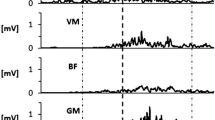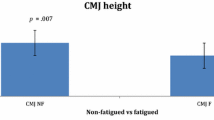Abstract
Purpose
The purpose of this study was to investigate the effects of surface instability on measures of performance and activity of leg and trunk muscles during drop jumps and landings.
Methods
Drop jumps and landings were assessed on a force plate under stable and unstable (balance pad on top of the force plate) conditions. Performance measures (contact time, jump height, peak ground reaction force) and electromyographic (EMG) activity of leg and trunk muscles were tested in 27 subjects (age 23 ± 3 years) during different time intervals (preactivation phase, braking phase, push-off phase).
Results
The performance of drop jumps under unstable compared to stable conditions produced a decrease in jump height (9 %, p < 0.001, f = 0.92) and an increase in peak ground reaction force (5 %, p = 0.022, f = 0.72), and time for braking phase (12 %, p < 0.001, f = 1.25). When performing drop jumps on unstable compared to stable surfaces, muscle activity was reduced in the lower extremities during the preactivation, braking and push-off phases (11–25 %, p < 0.05, 0.48 ≤ f ≤ 1.23). Additionally, when landing on unstable compared to stable conditions, reduced lower limb muscle activities were observed during the preactivation phase (7–60 %, p < 0.05, 0.50 ≤ f ≤ 3.62). Trunk muscle activity did not significantly differ between the test conditions for both jumping and landing tasks.
Conclusion
The present findings indicate that modified feedforward mechanisms in terms of lower leg muscle activities during the preactivation phase and/or possible alterations in leg muscle activity shortly after ground contact (i.e., braking phase) are responsible for performance decrements during jumping on unstable surfaces.


Similar content being viewed by others
References
Anderson K, Behm DG (2005) Trunk muscle activity increases with unstable squat movements. Can J Appl Physiol 30:33–45
Arampatzis A, Stafilidis S, Morey-Klapsing G, Brüggemann G (2004) Interaction of the Human Body and Surfaces of Different Stiffness during Drop Jumps. Med Sci Sports Exerc 36:451–459
Avela J, Santos PM, Komi PV (1996) Effects of differently induced stretch loads on neuromuscular control in drop jump exercise. Eur J Appl Physiol Occup Physiol 72:553–562
Bosco C, Saggini R, Viru A (1997) The influence of different floor stiffness on mechanical efficiency of leg extensor muscle. Ergonomics 40:670–679
Bressel E, Willardson JM, Thompson B, Fontana FE (2009) Effect of instruction, surface stability, and load intensity on trunk muscle activity. J Electromyogr Kinesiol 19:e500–e504
Cohen J (1988) Statistical power analysis for the behavioral sciences, 2nd edn. Erlbaum, Hillsdale
Coren S (1993) The lateral preference inventory for measurement of handedness, footedness, eyedness, and earedness: norms for young adults. Bull Psychon Soc 31:1–3
Dixon SJ, Collop AC, Batt ME (2000) Surface effects on ground reaction forces and lower extremity kinematics in running. Med Sci Sports Exerc 32:1919–1926
Drinkwater EJ, Pritchett EJ, Behm DG (2007) Effect of instability and resistance on unintentional squat-lifting kinetics. Int J Sports Physiol Perform 2:400–413
Dyhre-Poulsen P, Simonsen EB, Voigt M (1991) Dynamic control of muscle stiffness and H reflex modulation during hopping and jumping in man. J Physiol 437:287–304
Faul F, Erdfelder E, Lang A, Buchner A (2007) G*Power 3: a flexible statistical power analysis program for the social, behavioral, and biomedical sciences. Behav Res Methods 39:175–191
Ferris DP, Louie M, Farley CT (1998) Running in the real world: adjusting leg stiffness for different surfaces. Proc Biol Sci 265:989–994
Fleischmann J, Gehring D, Mornieux G, Gollhofer A (2010) Load-dependent movement regulation of lateral stretch shortening cycle jumps. Eur J Appl Physiol 110:177–187
Frey I, Berg A, Grathwohl D, Keul J (1999) Freiburg Questionnaire of physical activity-development, evaluation and application. Soz Praventivmed 44:55–64
Hermens HJ, Merletti R, Freriks B (1999) SENIAM: European recommendations for surface electromyography results of the SENIAM project, 2nd edn. Roessingh Research and Development, Enschede
Hewett TE, Zazulak BT, Ford KR (2005) A review of electromyographic activation levels, timing differences, and increased anterior cruciate ligament injury incidence in female athletes. Br J Sports Med 39:347–350
Hoffrén M, Ishikawa M, Rantalainen T, Avela J, Komi PV (2011) Age-related muscle activation profiles and joint stiffness regulation in repetitive hopping. J Electromyogr Kinesiol 21:483–491
Kerdok AE, Biewener AA, McMahon TA, Weyand PG, Herr HM (2002) Energetics and mechanics of human running on surfaces of different stiffnesses. J Appl Physiol 92:469–478
Komi PV (2000) Stretch-shortening cycle: a powerful model to study normal and fatigued muscle. J Biomech 33:1197–1206
Komi PV, Gollhofer A (1997) Stretch reflexes can have an important role in force enhancement during SSC exercise. J Appl Biomech 13:451–459
Konrad P (2005) ABC of EMG. A practical introduction to kinesiological electromyography
McBride JM, Cormie P, Deane R (2006) Isometric squat force output and muscle activity in stable and unstable conditions. J Strength Cond Res 20:915–918
McBride JM, Larkin TR, Dayne AM, Haines TL, Kirby TJ (2010) Effect of absolute and relative loading on muscle activity during stable and unstable squatting. Int J Sports Physiol Perform 5:177–183
Saeterbakken AH, Fimland MS (2013) Muscle force output and electromyographic activity in squats with various unstable surfaces. J Strength Cond Res 27:130–136
Taube W, Leukel C, Lauber B, Gollhofer A (2012) The drop height determines neuromuscular adaptations and changes in jump performance in stretch-shortening cycle training. Scand J Med Sci Sports 22:671–683
Zemková E, Jeleň M, Kováčiková Z, Ollé G, Vilman T, Hamar D (2012) Power outputs in the concentric phase of resistance exercises performed in the interval mode on stable and unstable surfaces. J Strength Cond Res 26:3230–3236
Acknowledgments
No sources of funding were used to assist in the preparation of this study.
Conflict of interest
The authors have no conflicts of interest that are directly relevant to the content of this study.
Author information
Authors and Affiliations
Corresponding author
Additional information
Communicated by Fausto Baldissera.
Rights and permissions
About this article
Cite this article
Prieske, O., Muehlbauer, T., Mueller, S. et al. Effects of surface instability on neuromuscular performance during drop jumps and landings. Eur J Appl Physiol 113, 2943–2951 (2013). https://doi.org/10.1007/s00421-013-2724-6
Received:
Accepted:
Published:
Issue Date:
DOI: https://doi.org/10.1007/s00421-013-2724-6




